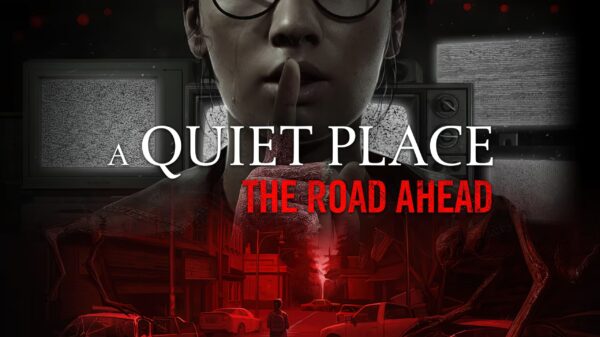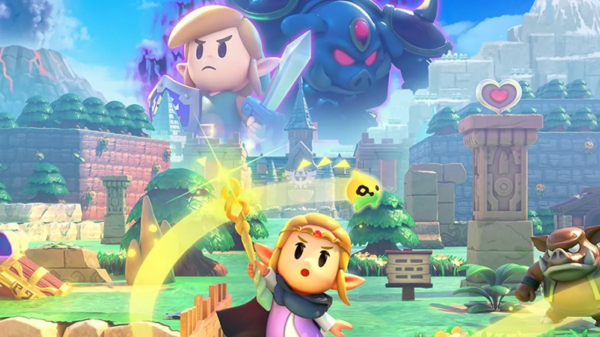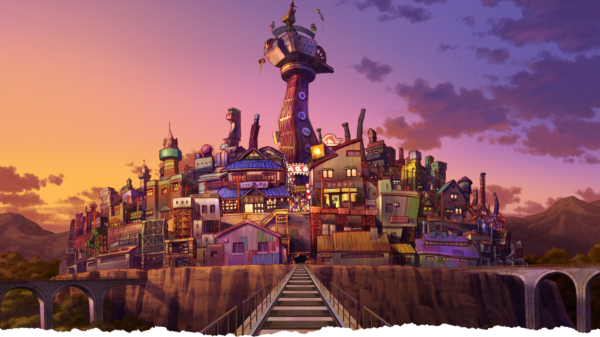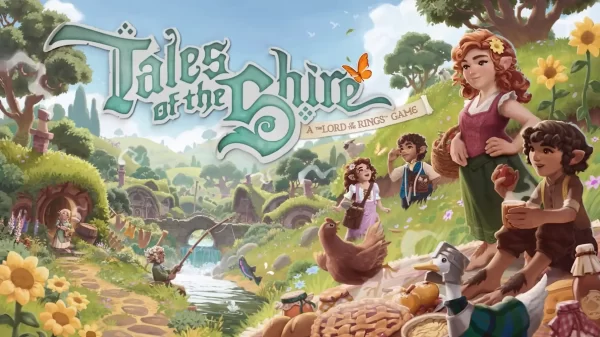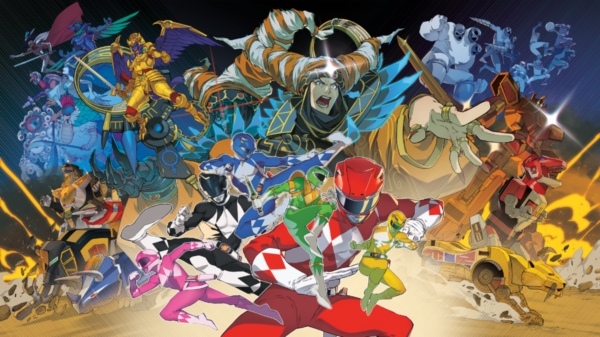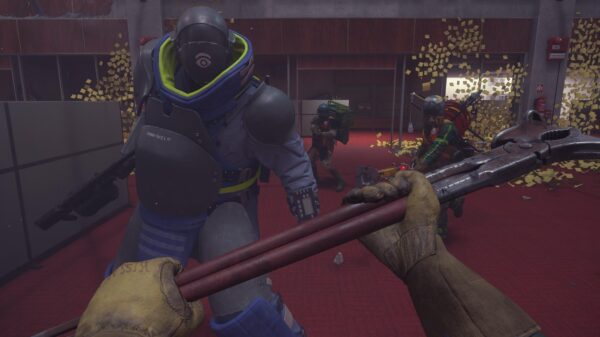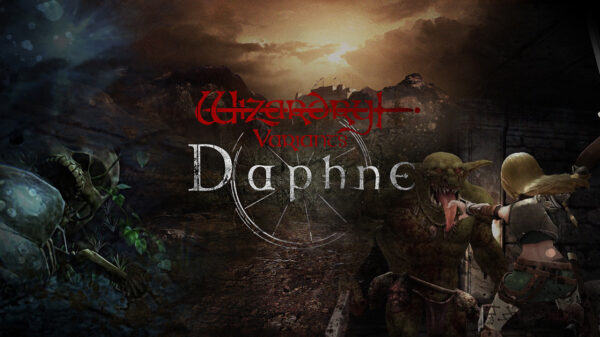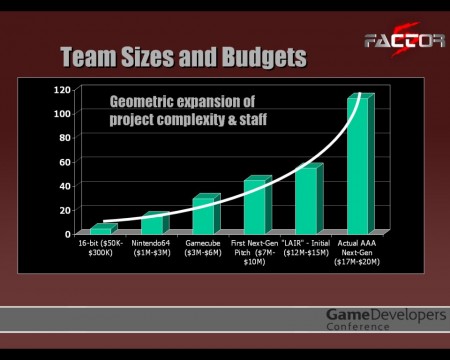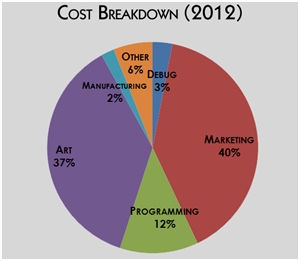A couple of months ago at the San Francisco International Film Festival, film director Steven Soderbergh (‘Side Effects,’ ‘Traffic’) delivered an insightful keynote address about the state of cinema in the current Hollywood industry. A successful and prolific filmmaker, Soderbergh gave his own personal perspective on what is happening in the industry along with his own interpretations of how the future will turn out for Hollywood filmmaking. One of the points he tossed out was a rather pertinent one that stretches relevance to not just film production and economics but also to the economics side of videogames and other forms of media. He lamented that in the current industry the upfront costs of distributing a mainstream film worldwide is roughly 60-70 million dollars, meaning that in order to break even on the distribution costs on a film, it would take at least 120 million dollars in revenue (since distributors get half the revenue) before the actual production budget of a film is even taken into account.
[youtube width=”500″ height=”300″]nhR_7D20CMk[/youtube]
Why is this a big deal? Well, let’s look at it this way: You have two films that the production studio is thinking of making. One is a smaller dramatic film that only takes several million dollars to produce, while another is a big action-adventure flick (on the scale of something like Transformers) that requires hundreds of millions of dollars to produce. Naturally, you would think that making the smaller film with the less budget would be less risky and be easier to break even. However, with a 120 million fee upfront for distribution, you should ask yourself which film is more likely to break even: the small dramatic film (more art-house leaning) or a large action-adventure popcorn flick with a bucketful of CGI action scenes made to appeal to the mass audience. Ultimately, studio executives would come up with the same conclusion you just came up with: despite the high production budget of the popcorn flick, it has a much higher chance of breaking even (and making a profit) and thus the risk associated with the high buy-in is mitigated by the low risk of failure, something that the smaller film’s risk projection cannot account for.
So the film industry is shifted towards large tent-pole blockbusters (been so since the 80’s with Jaws and Star Wars). So films that we watch in theaters are more likely to be the next Avengers or the next Transformers. So what? What does any of this have to do with videogames? Well, to put it simply, for the last decade or so, the videogame industry has been shifting towards an imitation of the film industry both in product and in economics. It is no mistaking that modern Triple-A videogames try as hard to they can to imitate Hollywood blockbuster films. Games such as Uncharted, Gears of War, and Call of Duty all try to invoke the popcorn action feel, maximizing the amount of grand action set pieces throughout its runtime while dishing out the best graphics game developers can make. Naturally, to make that happen, you will need more people spending more time to develop these games and more money to pay these people to do so.
A Gamespy article projected some alarming numbers for the state of game production. In this generation of consoles, it takes somewhere between 15 to 30 million dollars to produce a triple-A PS3 or XBox360 title. That amount is several times more expensive than a game made from the previous generation of consoles. We see that while the film industry is mired by high distribution costs associated with mainstream release, the videogame industry is similarly hindered by production/developmental costs and technological expectations. If it takes 30 million dollars to pay to make a Triple-A title in the current generation of consoles, the game must sell close to a million copies to just break even after accounting for physical retail fees and additional marketing.
When marketing is factored into the budget breakdown, the average triple-A videogame would turn to cost more than 40 million dollars on average in 2012 while making only 20 million dollars on average back in revenue. Marketing would account for 40 to 60 percent of the total budget for each title with some titles such as Call of Duty 4: Modern Warfare 2 having a marketing budget that is 400% its production costs. This increasing marketing budget shows off one of the rare situations where over-competitiveness is detrimental in an economic market. There is little chance a company’s titles are going to compete successfully in the market unless it spends millions on advertising for each title. And thus, a higher marketing budget equates to a higher number of copies for a title to sell in order to break even. In the end, the competitiveness of the market drives the inherent risk up for each triple-A title.
Higher production costs for newer videogames make each investment a riskier gamble than in the past. Factor 5’s Lair and its commercial failure brought about the company’s untimely demise. Recently, videogame giant, THQ, filed for Chapter 11 bankruptcy after its newer franchises such as Darksiders and Metro 2033 failed to sell successfully enough to break even with their high production costs. Similarly, Sega has been laying off much of its workforce and scaling back its productions after recent weak sales of its high cost products. There are as many big budgeted failures as there are successes. For each record-setting Call of Duty game out there, there is a Triple-A title doomed to commercial failure and a studio suffering irreparable losses.
The Doom and Gloom
The inherent higher risks associated with higher budgets required for each title essentially produces the Hollywood effect in the videogame industry. The expensive nature of the buy-in for each mainstream picture in Hollywood makes companies risk-adverse and thus more focused on making titles that are easy to sell and appeal to a broad audience. These titles are essentially large scale action-adventure flicks, CGI splurges on the big screen, sequels of successfully franchises, or a combination of all three. Looking at the best selling videogames of the last few years (Call of Duty 4: Black Ops 2, Halo 4), it feels like a déjà-vu experience that has already been hammered into our brains by the blockbusters of our local cinemas. Videogame developers and publishers are becoming more risk adverse, choosing to only produce old and established franchises or games imitative of Hollywood blockbusters. Newer franchises that take risks or try to venture into new territories often lead to failures that outright damage the company financially, as exemplified by the THQ bankruptcy. As Soderbergh puts it in a way that can be applied to both movies and videogames, “the bigger the budget, the more people this thing is going to have to appeal to, the more homogenized it’s got to be, the more simplified it’s got to be. So things like cultural specificity and narrative complexity, and, god forbid, ambiguity, those become real obstacles to the success” of the product. Simply put, there will be a decreasing amount of creativity and an increasing amount of homogeneity in Triple-A titles.
Another opportunity cost to the increasing budget of Triple-A titles is one that is detrimental to the consumer. Videogame prices are decided percentage-wise by how much production, marketing, distribution cost the developers and publishers. By driving up production costs, there is a greater need to compensate by driving up the prices of the products in order to break even. Videogames prices average around 60 dollars or more nowadays depending on where you live and have a fair chance of increasing as the next gen rolls around. While it doesn’t seem like it will reach the projected price of 120 dollars a game in 2014, at what point will the price of videogames outweigh its marginal utility?
The next generation of consoles will only worsen the problems. Consumers have a higher technological expectation for their products, craving more explosive set pieces and better graphics. The resulting games will be more expensive, require more people to work on it, and have production values close to ones of Hollywood blockbusters. Consider the most expensively budgeted videogame of this generation – Star Wars: the Old Republic at 200 million dollars in production cost. This anomaly might just become the future standard of videogame production. This economic standard punishes small developers and large risk-taking developers tremendously, making market penetration far more difficult and riskier than ever before.
The Silver Lining
Despite all of my apocalyptic musings about the current videogame industry, there is a silver lining to this downward spiral. The videogame industry is, much like other markets, an organic being with its own tools for maintaining a homeostatic equilibrium. When things are getting out of hand and the industry teeters on the brink of disaster, there is always something positive that arises and tries to balance it out.
For one, I believe that the videogame industry is a much more recoverable industry than the film industry. While this might not be saying very much, I believe that it is the flexibility of the industry that gives it the ability to recover and balance itself out. The film industry is stuck on an antiquated way of distribution and revenue generation. Most of the time, films depend on theatrical releases and distribution in order to break even, which, as explained in the opening paragraphs, is a catch-22. After breaking even at the box office, the films rely on sales of physical products to make a profit. Only recently have Netflix and pay-per-view stirred up some change in the distribution and sales system of the film industry, but the change is slow and the industry has been resistant to novelty. The videogame industry, on the other hand, is an industry that embraces the digitization of distribution with popular online platforms such as Steam, Xbox Live Arcade, PSN, and other venues of online distributions. The digitization of distribution is highly beneficial for a few reasons. One reason is that foregoing the physical copy of the videogame decreases the prices of product. Since retail stores typically receive up to 20% of the price of a videogame as commission, the displacement of this middleman allows the consumers to get videogames for a cheaper price and also grant the company higher revenue for each copy sold. Another reason for digitalization is the increased availability of the product to the general public and the ease of purchase. This aspect greatly benefits independent developers since the digital distribution of indie games allows for greater exposure, decreased distribution fees, and easier acquisitions of these games by the general public, all aspects that independent movies have trouble with in the film industry.
These aspects of digitalization has led to a boom in indie games in which low cost indie games are given enough grounds for distribution to garner profit several times the cost. With production costs ranging from 100,000 to 1 million dollars and fan-funding services such as Kickstarter, making an indie game with an original or innovative idea seems like a profitable venture with comparatively less risk than developing Triple-A titles. As of now, independent videogames are the place to go to for creativity and originality in the industry. While several sites have speculated on the upcoming bust cycle of the indie games boom, this collective burst of energy and creativity is a truly rare and optimistic occasion for the whole industry; a bright ray of optimism in a darkening cloud.
[youtube width=”500″ height=”300″]tk-RsawGjPY[/youtube]
Perhaps this is what Soderbergh was talking about at the end of his keynote address; that at the end of the day, at the end of his speech, and at the end of this article: it is about hope.
References:
http://www.deadline.com/2013/04/steven-soderbergh-state-of-cinema-address/
http://www.notenoughshaders.com/2012/07/02/the-rise-of-costs-the-fall-of-gaming/
http://www.p4rgaming.com/video-game-budget-breakdown-infographic/
http://www.gamespy.com/articles/108/1082176p1.html


